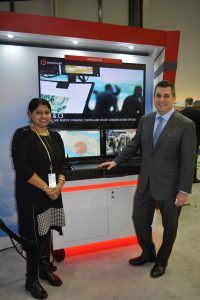
Todd Probert, VP Mission Support & Modernization, Raytheon Briefing About Windshear To Chaitali Bag ADU At IDEX 2019. (Transcribed Video).
Good morning, I’m Todd Probert, from Raytheon and we’re here today to talk about our wind shear system, so wind shear is addressing the counter UAS market and you just have to look in any paper on any given week and see the drones and other UAS systems are causing all sorts of turmoil across any number of UAS cases so the airport UAS case either in Dubai or most recently in Gatwick, in London has been a concern for us so what we’ve done here at Raytheon is build a command and control system and that command and control system, first and foremost, it’s about situational awareness and you need to understand your environment so for many many years we’ve been in the air traffic control market and out of that we’ve worked with any number of partners to make sure that’s we can understand the UAV, the drones that are out there and then with that we’ve coupled an open architecture to allow us to bring in any number of effectors so we set up fence line so you can see here the various fence lines and when you’re looking at a UAV threat, many many of the threats that we’re seeing today are just nuisance threats, operators that don’t necessarily understand what they’re doing, so the outer edge of that line will have bells, whistles, alarms that will do the work through it, but as a UAV moves through those various fence lines, we have any number of increasingly measured effects to go take care of it. So in one sense first fence line might be protocols taking over by the command control of the vehicle itself, if it gets past that threat, jamming the command and control signal or the GPS signal of the UAV to take it down in a soft fashion and then we can layer this in because it’s an open architecture with more kinetic effectors that is more classic in the air defence that Raytheon’s done for many many years.

Okay, so what you see behind me is our medium range, so this is in the one or two kilometre standoff distance but we have tower mounted systems so I think a south tower where we can see at five kilometres and beyond and then we layer that in with other RADAR system so we’ve got a product called low-power RADAR and it’s essentially a design for a netted solution in the space between the air traffic control regime that’s already out there and the actual ground where the drones would be flying, so it’s a layered response and really again wind shear is set up to allow us to have a layered defence and then as threats evolve and effects of all bring those effects into the control environment kind of as we move forward.
So drones and UAVs and protecting various either be at an airport or may be a sporting event in the stadium or other tourist venues are becoming more and more of a concern so if you think about it, it’s about the economies of scale. Here drones have come to the price point where you can go to a radio shack or a typical store and buy a drone for on the order for a couple of hundred dollars so the proliferation of these systems is a concern and the ability for a potential bad factor to acquire one of these things and do harm with them is something that we’ve seen increasing concern across various number of UAS cases so the airport scenario here in Dubai here recently is certainly one of those cases but then looking at even events like this today where you have a number of people here at the trade-show you really want to protect those people you need a solution first to make sure you have situational awareness of what’s going on and then second to take the action if you decide that something is indeed a threat.
So we’re seeing the increased use of drones around the world and certainly here locally so that the recent incursion in the Dubai airport makes it topical for the region but when you see the various technology that’s moving into the MENA region, drones are being proliferated considerably across the population so again even in the private use case where you have an inexperienced operator encouraging in potentially bringing that drone into us, into an environment that it shouldn’t be in, I mean I think that’s something that we’re seeing certainly locally and around the world and then of course various factors are always a concern and again for very low dollars a couple of hundred dollars you can get a pretty sophisticated drone they can fly at altitudes that are, that could do harm either for commercial aviation or certainly into private venues, stadiums, tourist events in the like.
























































































































